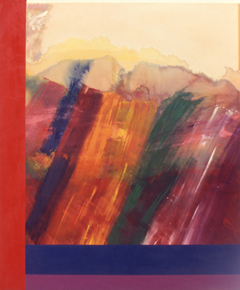
Ronnie Landfield is an American abstract painter. During his early career from the mid-1960s through the 1970s his paintings were associated with Lyrical Abstraction, and he was represented by the David Whitney Gallery and the André Emmerich Gallery.
Mary Frank is an English visual artist who works as a sculptor, painter, printmaker, draftswoman, and illustrator.

Yvonne Helene Jacquette was an American painter, printmaker, and educator. She was known in particular for her depictions of aerial landscapes, especially her low-altitude and oblique aerial views of cities or towns, often painted using a distinctive, pointillistic technique. Through her marriage with Rudy Burckhardt, she was a member of the Burckhardt family by marriage. Her son is Tom Burckhardt.
Idelle Lois Weber was an American artist most closely aligned with the Pop art and Photorealist movements.
Lois Dodd is an American painter. Dodd was a key member of New York's postwar art scene. She played a large part and was involved in the wave of modern artists including Alex Katz and Yvonne Jacquette who explored the coast of Maine in the latter half of the 20th century.
Squeak Carnwath is an American contemporary painter and arts educator. She is a professor emerita of art at the University of California, Berkeley. She has a studio in Oakland, California, where she has lived and worked since 1970.
Mel Kendrick is an American visual artist and sculptor known primarily for his abstract, three-dimensional forms derived from sliced and reconstituted wooden blocks. Kendrick's work is understood to reflect a deep fascination with process, space, geometry, and natural forms and materials.

Edward Dugmore was an abstract expressionist painter with close ties to both the San Francisco and New York art worlds in the post-war era following World War II. Since 1950 he had more than two dozen solo exhibitions of his paintings in galleries across the United States. His paintings have been seen in hundreds of group exhibitions over the years.

Dannielle Tegeder is a contemporary artist who works with installation, animation and sound and is best known for her abstract paintings and drawings. She lives in Brooklyn, New York and maintains a studio at The Elizabeth Foundation in Times Square, Manhattan.
Jack Albert Youngerman was an American artist known for his constructions and paintings.
George Earl Ortman was an American painter, printmaker, constructionist and sculptor. His work has been referred to as Neo-Dada, pop art, minimalism and hard-edge painting. His constructions, built with a variety of materials and objects, deal with the exploration off visual language derived from geometry—geometry as symbol and sign.
Thomas Browne Cornell was an American artist.
Michael Kessler is an American artist.
Nancy Grossman is an American artist. Grossman is best known for her wood and leather sculptures of heads.

Polly E. Apfelbaum is an American contemporary visual artist, who is primarily known for her colorful drawings, sculptures, and fabric floor pieces, which she refers to as "fallen paintings". She currently lives and works in New York City, New York.
Sarai Sherman was a Pennsylvania-born Jewish American artist whose work, both in America and Europe shaped international views of women and abstract expressionism. She was a significant twentieth century painter and sculptor known for her abstract paintings, prints and ceramics.
Ann Pibal is an American painter who makes geometric compositions using acrylic paint on aluminum panel. The geometric intensity is one of the key characteristics that defines her paintings.
Harriet Shorr, was an American artist, writer, poet and professor. She was known for large-scale realistic still life paintings.
Nancy Genn is an American artist living and working in Berkeley, California known for works in a variety of media, including paintings, bronze sculpture, printmaking, and handmade paper rooted in the Japanese washi paper making tradition. Her work explores geometric abstraction, non-objective form, and calligraphic mark making, and features light, landscape, water, and architecture motifs. She is influenced by her extensive travels, and Asian craft, aesthetics and spiritual traditions.
Marsha Cottrell is an American artist.






